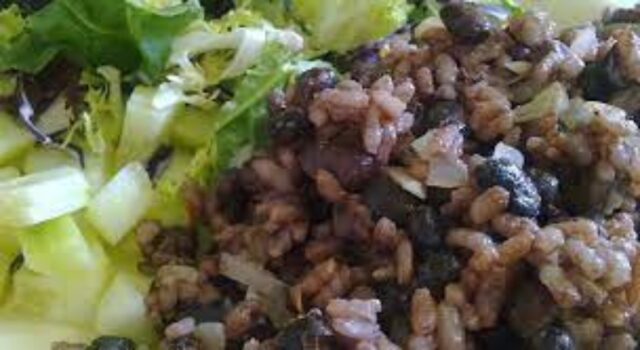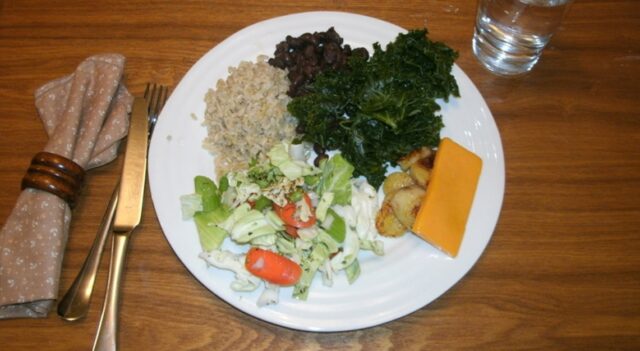Delicious tropical fruits, rice and beans, cassava… These are just some of the foods that you will find in the meals and drinks that you can enjoy in Costa Rica and that you cannot stop trying, if you travel to this wonderful Central American country. In this post, I give you some of the keys so that you do not miss any of the essential options.
The gallo pinto

Surely if we talk about this dish, the first thing that may come to mind is that it is made with rooster. Nothing is further from reality. Gallo pinto (colored rooster) is a rice dish with black beans, accompanied by fried eggs, and it gets its name because the combination of beans (black and red) with white rice can remind us the colors of that bird.
Besides being traditional in Costa Rica, it is also traditional in Nicaragua. In other countries and areas of the Caribbean there is a variant known as ‘rice and beans’ in which the ingredients are cooked in coconut milk. In many other Latin American countries, it is also common to find these 2 foods combined in the same dish and in different varieties.
The casado

We also repeat in this dish the boiled white rice and beans, although, in this case, these 2 foods and a sweet fried banana are usually accompanied by beef, pork, chicken or fish. In addition, it often also includes a garnish of cabbage, potato or cassava and some pasta in different forms.
Along with the gallo pinto, and the olla de carne (pot of meat), the casado (married one) is one of the 3 main dishes of Costa Rican cuisine. It is a mestizo food since it combines the 3 main gastronomic influences in Costa Rica (European, indigenous, and African) by integrating rice, brought by the Spanish, beans, consumed by Africans and indigenous people, pasta, contributed by Italians; fried plantain, from Afro-Caribbean cuisine; and picadillos, inspired by Andalusian stews.
Surely, this dish will not leave you being hungry!
The palm heart salad

Currently, Costa Rica is the second largest producer of palm hearts in the world, behind Ecuador. For this reason, the salad in which this food is used is a very important and basic dish in its gastronomy and that you cannot stop trying on your trip to this country.
Cassava
We continue with the foods that Costa Rica can boast of being a producer. In this case, we are talking about yucca, a product with brown skin and a white interior that you will find as an accompaniment in many of its dishes and cooked in different ways, although most of the time you will see it fried.
Meat in sauce
Taken normally at lunchtime, this dish, which repeats some of the elements mentioned above, such as white rice or salad, is made with meat prepared in a pot and accompanied with foods such as onion, cilantro, garlic, or tomato.
The olla de carne
As I have mentioned previously, this is one of the 3 main dishes of Costa Rica and its origin in the country dates back more than 100 years. It is a stew that is prepared in a pot, usually under pressure, and that has meat, seasoned with onion, salt, pepper, oregano or celery, among others, and vegetables that are added to the process at the last moment so that they do not come undone. The dish is accompanied by white rice, tortillas, and hot chili.
The central markets of each province of the country, the Central Market of San José, Heredia and Alajuela are popular for the preparation of this meal, which is usually presented by dividing the vegetables in a large plate, the broth and the meat in a bowl and another medium plate with the rice. If you are invited to eat it at home, surely they will also present it to you like that, especially if you go during the weekend.
If you have been to Colombia, you may have tried sancocho, a variant of this Costa Rican dish.
The arracache
We are now talking about a vegetable that is harvested twice a year, the arracache, and that is usually presented on the plate accompanied by meat and vegetables. It is, in this case, one of the most common picadillos in Costa Rica.
Bread pudding
Pudding is a dessert that can be found in many parts of the world, you may be thinking. But surely you have not tried a homemade one like the one they prepare in rural areas of Costa Rica. And although there are multiple types of pudding, bread is the most traditional.
This delicacy is baked at 375 °C and, when cooked, a little condensed milk is added on top and it is browned for about five minutes. Who is not making their mouths water, as they imagine having one of these puddings to accompany a coffee?
Tropical fruit juices
Nothing better to lower the heat caused by the high temperatures that Costa Rica usually has than a good, very cool tropical fruit juice. Pineapple, banana, passion fruit or mango will be just some of the fruits that you can enjoy in this country in a juice and that will appeal to you at any time of day and at any time of your trip.
The resbaladera (slipping board)
We finish with another refreshing drink that usually accompanies the breakfast of any Costa Rican. In this case, we are talking about a typical drink from the north of the country: resbaladera. This is prepared with rice and milk, cinnamon, nutmeg and vanilla, among other ingredients. And for being also very cool; you will feel like it at any time of the day!
And you; what flavor of Costa Rican gastronomy are you wanting to try?


